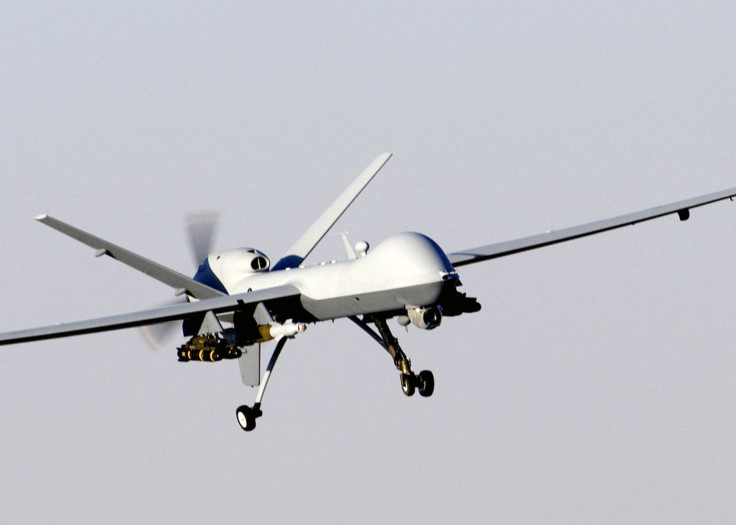Immigration Reform 2013: Drones Are Costly Border Security Tools With Few Results To Show

U.S. senators were able to break an impasse over border security in the 2013 immigration reform bill by throwing approximately $30 billion at the problem, soothing conservatives’ concern and boosting the measure’s ability to pass the chamber with a supermajority.
For $30 billion, conservatives are getting 20,000 additional boots on the ground patrolling the southern border, 700 miles of fencing, and drones and other combat zone-efficient technologies to crack down on illegal border crossings that are currently at a 40-year low.
Indeed, lawmakers can afford to spend that much money, especially after the Congressional Budget Office forecast a near $1 trillion savings over the next 20 years if comprehensive immigration reform is enacted. However, the cost-effectiveness of adding more drones on the border is being heavily criticized. Some experts say it doesn’t make sense to add more drones on the border -- even if they can be paid for -- because these unmanned aerial systems have more success in narcotics seizures than they do in illegal immigrants’ apprehension.
According to Customs and Border Protection data, drones have contributed to the seizure of more than 66,000 pounds of narcotics last fiscal year and only 143 people involved in illegal activities. That’s after flying 5,700 hours in fiscal 2012. It costs $18 million to buy one drone and between $2,500 and $3,000 an hour to operate predator or reaper drones.
“It is a lot of money spent on not much result,” Tom Barry, senior policy analyst for Latin American Relations and Security at Center for International Policy, said. “One could also question if border security should be measured by how many pounds of marijuana cross the border.”
What’s more is that CBP doesn’t seem to have a strategy for drone use along the border. A May 2012 report from the U.S. Department of Homeland Security Office of the Inspector General found poor program planning and resource management. The agency also failed to prepare an adequate operations and maintenance budget and thus had a $25 million shortfall in fiscal 2010 and had to take from other programs to make up for it.
The IG report showed that Congress appropriated $12.6 million for the program’s operations and maintenance since the program started in fiscal 2004. From fiscal 2006 to 2011, CBP spent $55.3 million specifically for that type of work.
The inspector general made four recommendations to the agency, one of which was to postpone further purchases of unmanned aerial systems -- that is, until officials develop a plan for acquiring funding for their operation and maintenance and until there is analysis of the requirements for these tools and strategy for how to achieve mission objectives.
What's more, CBP didn’t even achieve the desired level of flight hours for the several drones in its possession. The IG estimated that drones should support 10,662 flight hours per year to meet the minimum capability of the mission and about 13,328 flight hours to meet desired capability. However, they are being underutilized. There were just 7,336 flight hours coming from the seven drones and 3,909 hours of actual flight hours. The inspector general report stated this resulted from the lack of qualified staff and equipment, as well as restrictions by the Federal Aviation Administration and weather, among other things.
“If you don’t think this solves border security, I don’t know what will,” U.S. Sen. Chuck Schumer, D-N.Y., said of the new bill. He is the chief architect of the main immigration reform bill that seeks to legalize the 11 million undocumented immigrants presently in the country, 40 percent of whom have reportedly overstayed their visas. That means they came to the United States legally.
Using high-tech capabilities to solve the nation’s immigration problem makes sense given the times, many analysts agree. However, the question remains whether more drones and agents along the border is the best way to go.
As Alex Nowrasteh, an immigration policy analyst at the Cato Institute, pointed out last week, beefing up border security maybe a strong political argument, but the actual result is “very minimal.”
“Immigrants are drawn to the United States because of economic opportunity, and what has decreased immigrant crossings is not increased enforcement but decreased opportunities when they come here,” he said.
With a weak U.S. job market, an already dangerous border and declining birth rates in Mexico (stemming, in part, from improved economic conditions in Mexico), it appears some of the U.S.'s problem is being solved.
It makes better sense then to focus on the interior, Barryt said, especially seeing that drones are generally sent out to the field when sensors detect movement. These unmanned vehicles cannot physically apprehend illegal crossers -- manpower will still need to be deployed. In focusing on the interior, there must be the successful implementation of an E-Verify system for all employers -- something proposed in the new border security surge bill. The U.S. House recently passed a bill that does exactly that. However, Barry doesn’t like the idea of deputizing local and state law enforcement agency to undertake federal immigration law enforcement, and that is what Republican Representative from South Carolina Trey Gowdy’s bill is proposing.
“In the end, this border security buildup is opportunistic -- politically by the right, opportunistically by the Democrats who live by the border because they love to get all this money into their districts,” Barry said. “The federal government should be faulted for not providing real cost-benefits evaluation of what has been effective and what has not been effective to allow this discussion of high-tech security drones. ... It makes you indignant against kind of the traditional anti-big government kind of thing. Just ridiculous.”
© Copyright IBTimes 2024. All rights reserved.





















